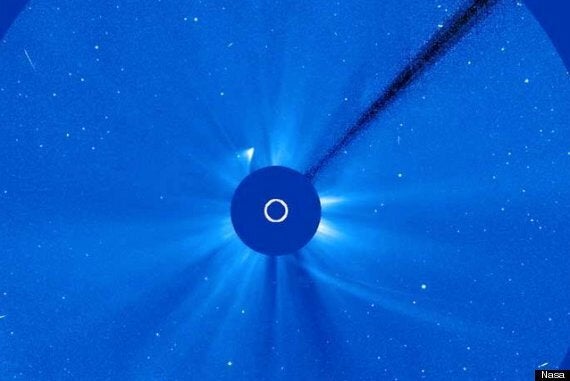Ison lives.
Comet Ison, once called the potential 'comet of the century', initially disappointed astronomers on Thursday after it appeared to fizzle after a close approach to the surface of the Sun.
It had been hoped the 2KM-wide comet might survive the encounter and shine brightly in the night sky as a result. But Nasa said that instead the comet cracked under the pressure. Ison, we were told, was dead. We mourned.
And yet…
A new photo captured by Nasa's Solar and Heliospheric Observatory shows that while most of the comet appears to have disintegrated, something definitely survived the journey.

Above: The photo clearly shows that part of the comet has survived and is brighter than ever.
Karl Battams, a comet scientist for the Naval Research Laboratory, told CNN:
"It now looks like some chunk of ISON's nucleus has indeed made it through the solar corona, and re-emerged. It's throwing off dust and (probably) gas, but we don't know how long it can sustain that."
It's not known yet what remnant of the comet has made it out of the Sun's glare, or what that might mean for astronomers. But for now, we have hope that some part of the comet might still give us a little Christmas sparkle.
Nasa solar physicist Alex Young said it would take a few hours to confirm Ison's demise, but things were not looking good.
He said the comet had been expected to appear in images from the Solar Dynamics Observatory spacecraft at around 5pm British time, but almost four hours later there was "no sign of it whatsoever".
He added: "Maybe over the last couple of days it's been breaking up. The nucleus could have been gone a day or so ago."
The comet was discovered last year by two amateur astronomers using Russia's International Scientific Optical Network (Ison).
It was born in the Oort cloud, a shell of scattered icy objects right at the outermost edge of the Solar System. The cloud is nearly a light year from the sun, a quarter of the distance to our nearest neighbouring star, Proxima Centauri.
Sometimes a comet is nudged out of the cloud by the gravitational tug of a passing star, and sent on a journey taking millions of years that eventually brings it into the inner Solar System.
Computer models show that Ison is one such comet. However, it is unusual in being a first-time visitor and also in a sun-grazing orbit.